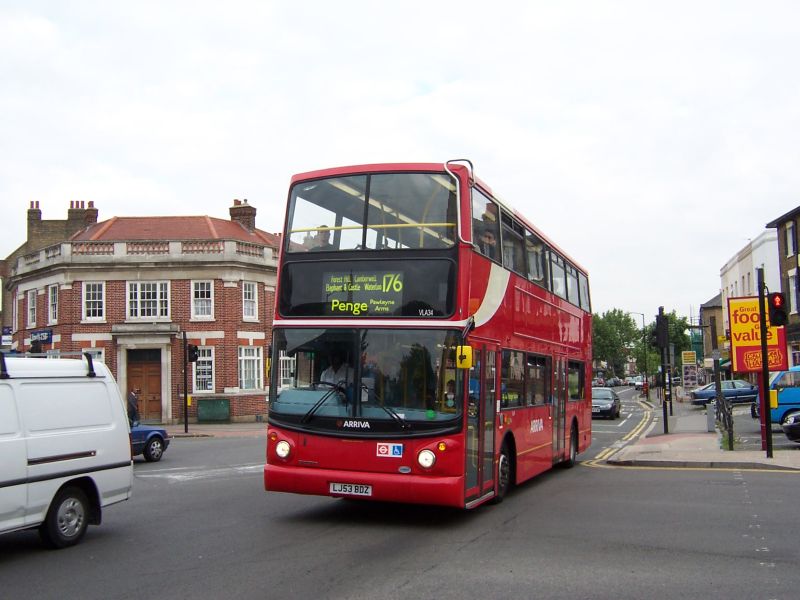 | Photo © John Gillespie. |
Home | Bus routes | Operational details | Service changes | Operators & Garages | Photo gallery
Following a number of type changes in recent years, the 176 has now settled down with low floor buses, having been the last major route operated with high floor buses, other than Routemaster routes. Here VLA 34 (LJ53 BDZ) crosses the Dulwich Library junction (terminus of the 12, famous as Dulwich ‘Plough’) on 27 July 2004.
 | Photo © John Gillespie. |
London & Country had won the 176 from 10 November 1990, and obtained a batch of East Lancs bodied Volvo Citybuses, H648-684GPF (excluding 666). Under Cowie ownership, these operations passed to the new Kentish Bus-controlled LondonLinks unit. The 176 was split between Beddington Farm and Walworth garages, the latter also operating the 78 and 188. However, expiry of the lease at Walworth prompted a shuffling of routes in which the 176 and 188 moved to fellow Cowie subsidiary South London Transport’s Norwood garage, together with the 36 East Lancs bodied Citybuses.
But the Citybus, with its high floor, did not lend itself to the dual door layout, and accidents involving passengers getting shut in the centre doors were all too common, so Arriva (as Cowie became) sensibly took the decision to transfer them out of London, enabling them to be converted to single door. The requirement in the contract for modern double deckers on the 176 was met with some Northern Counties-bodied Leyland Olympins acquired from Kentish Bus, who had used them on routes 22A and 22B (now 242). In practice these became mixed with Norwood’s own, and slightly older, ECW bodied Leyland Olympians.
The 176 route itself was one of the tram replacement routes, initially running from Catford, joining the existing route at Forest Hill as far as the Elephant. There were then two routes, 176 and 176A, the 176 continuing via Westminster Bridge to the Victoria Embankment, one of the major termini for south east London tram routes. However the trams only stopped there because that was as far as they were allowed to go, and it was soon realised that extending the buses further into central London would benefit passengers. Incidentally, the 176 is the only one of the original Victoria Embankment routes still to serve central London under its original number! Meanwhile the 176A went to Southwark Bridge, again not a terribly clever terminus, the route being abandoned in the September 1982 bus cuts.
It wasn’t long before the 176 was diverted at Elephant via Waterloo, Trafalgar Square, Tottenham Court Road, Marylebone and Edgware Road to Willesden, furthermore being extended into Lewisham for some years, albeit losing its Saturday service (it never had a Sunday service). The eastern terminus later settled down as Forest Hill. Leyland Titans, initially in crew mode, were introduced from Walworth garage in 1984, together with a Saturday only 185A (Lewisham – Elephant & Castle) that provided some compensation for the lack of a Saturday service on the 176.
The 176 was re-structured in 1987. The service north of Tottenham Court Road Station was withdrawn, buses running instead to Oxford Circus. The section to Willesden transferred to new route 172, but that did not last long. A Saturday service between East Dulwich and Oxford Circus, and a Sunday service between East Dulwich and Waterloo, were also introduced at this time. The south end was altered to run to Penge on a daily basis from 14/08/88, replacing the most heavily used section of route 12 south of Dulwich Plough. The Sunday service was extended to Aldwych in 1989 and finally reached Oxford Circus in 1994.
The net effect is that the 176 is a useful device for the people of Penge, Sydenham, Forest Hill and East Dulwich to get into the West End, the through journey taking just over an hour offpeak.
Navigation
| Previous | Next | |
| Chronologically | 340 | 194 |
| Numerically | 175 | 179 |
Photo Gallery | Bus route list | Operational details | Service changes | Operators & Garages